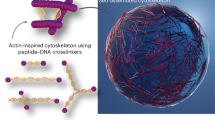Abstract
SPECTRIN is a high molecular weight protein located on the cytoplasmic surface of the mammalian erythrocyte membrane, from which it may be readily liberated by extraction with solutions of low ionic strength. It is thought to be a major structural element of the cell and to play a critical part in maintaining its discoid shape and characteristic viscoelastic properties. Birchmeier and Singer1 have shown that changes in the shape of red cell ghosts are associated with the phosphorylation of a single serine residue on one of the two spectrin subunits, and have suggested that this might provide a basis for the well-known control of red cell shape by ATP2. The erythrocyte membrane also contains actin, which is present in approximately equimolar proportions to the spectrin dimer (molecular weight 500,000 (ref. 3)). We have shown previously4 that there is a specific interaction between these two proteins, which reveals itself in the ability of spectrin to provoke the polymerisation of muscle actin in vitro. We show here that this effect depends on the phosphorylation of spectrin. Furthermore, in an undis-persed mixture of spectrin and its cognate actin such phosphorylation causes the formation of a gel. The striking parallel between these results and the previously demonstrated effects of phosphorylation in situ suggests that the shape of the cell is controlled primarily by the actin–spectrin complex.
This is a preview of subscription content, access via your institution
Access options
Subscribe to this journal
Receive 51 print issues and online access
$199.00 per year
only $3.90 per issue
Buy this article
- Purchase on Springer Link
- Instant access to full article PDF
Prices may be subject to local taxes which are calculated during checkout
Similar content being viewed by others
References
Birchmeier, W. & Singer, S. J. J. Cell Biol. 73, 647–659 (1977).
Makato, N., Nakao, T., Yamazoe, S. Nature 187, 945–946 (1960).
Gratzer, W. B. & Beaven, G. H. Eur. J. Biochem. 58, 403–409 (1975).
Pinder, J. C., Bray, D. & Gratzer, W. B. Nature 258, 765–766 (1975).
Rubin, C. S., Erlichman, J. & Rosen, O. M. J. biol. Chem. 247, 6135–6139 (1972).
Avruch, J. & Fairbanks, G. Biochemistry 13, 5507–5514 (1974).
Hosey, M. M. & Tao, M. Biochim. biophys. Acta 482, 348–357 (1977).
Dodge, J. T., Mitchell, C. & Hanahan, D. J. Archs Biochem. 100, 119–130 (1963).
Pinder, J. C., Tidmarsh, S. & Gratzer, W. B. Archs Biochem. 172, 654–660 (1976).
Yu, J., Fischman, D. A. & Steck, T. L. J. supramol. Struct. 1, 233–248 (1973).
Lazarides, E. & Lindberg, U. Proc. natn. Acad. Sci. U.S.A. 71, 4742–4746 (1974).
Hitchcock, S. E., Carlsson, L. & Lindberg, U. Cell 7, 531–542 (1976).
Garrels, J. I. & Gibson, W. Cell 9, 793–805 (1976).
Hiller, G. & Weber, K. Nature 266, 181–183 (1977).
Hitchcock, S. E. J. Cell Biol. 74, 1–15 (1977).
Jaenicke, L. Analyt. Biochem. 61, 623–627 (1974).
Marchesi, V. T. Meth. Enzym. 32, 275–277 (1974).
Spudich, J. A. & Watt, S. J. J. biol. Chem. 246, 4866–4871 (1971).
Laemmli, U. K. Nature 227, 680–685 (1970).
Author information
Authors and Affiliations
Rights and permissions
About this article
Cite this article
PINDER, J., BRAY, D. & GRATZER, W. Control of interaction of spectrin and actin by phosphorylation. Nature 270, 752–754 (1977). https://doi.org/10.1038/270752a0
Received:
Accepted:
Published:
Issue Date:
DOI: https://doi.org/10.1038/270752a0
This article is cited by
-
Multiple Functions of Spectrin: Convergent Effects
The Journal of Membrane Biology (2020)
-
Spectrin-based skeleton as an actor in cell signaling
Cellular and Molecular Life Sciences (2012)
-
Role of calcium and erythrocyte cytoskeleton phosphorylation in the invasion ofPlasmodium falciparum
Parasitology Research (1990)
-
Erythrocyte membrane sidedness in lectin control of the Ca2+–A23187-mediated diskocyte ⇄ echinocyte conversion
Nature (1981)
-
Spectrin tetramer–dimer equilibrium and the stability of erythrocyte membrane skeletons
Nature (1980)
Comments
By submitting a comment you agree to abide by our Terms and Community Guidelines. If you find something abusive or that does not comply with our terms or guidelines please flag it as inappropriate.



